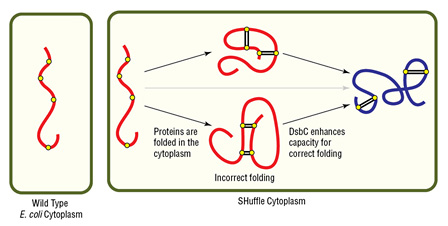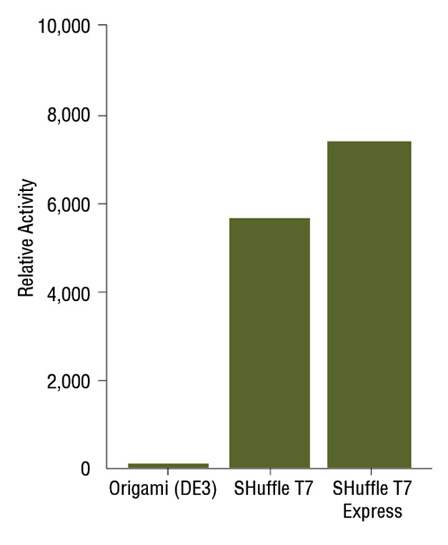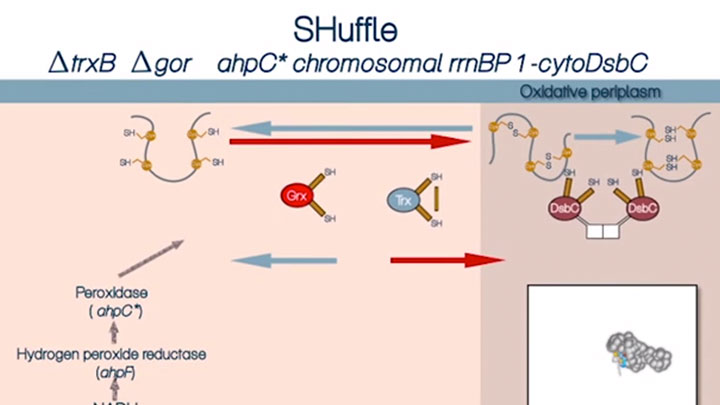Disulfide-bonded Protein Expression
Choose Type:
- Does my protein have disulfide bonds?
- What applications are SHuffle® strains useful for?
- Which SHuffle® strain should I use?
- How do SHuffle® strains aid in cytoplasmic disulfide bond formation?
- Is the PURExpress® In Vitro Protein Synthesis Kit capable of dealing with disulfide bonds? If not, can you recommend something else to use post synthesis?
- Analysis of Synthesized Protein using PURExpress (E6800)
- Determination of Protein Synthesis Yield with PURExpress (E3313, E6800, E6840, E6850)
- Expression Using SHuffle (C3026)
- Expression Using SHuffle (C3028)
- Expression Using SHuffle (C3029)
- Expression Using SHuffle (C3030)
- Transformation Protocol (#C3029, #C3026, #C3028 and #C3030)
- Protein Synthesis Reaction using PURExpress (E6800)
- PURExpress Disulfide Bond Enhancer (E6820)
- Protein Expression with T7 Express strains
- Purification of Synthesized Protein using Reverse His-tag Purification
- Preparation of Media and Solutions (E6901)
- High Efficiency Transformation Protocol (C3025)
- Transformation Protocol (C3032)
- 5 Minute Transformation Protocol (C3026)
- Fusion Constructs (E6901)
- Measurement of 35S-Methionine Incorporation by TCA Precipitation and Yield Determination using PURExpress
- 5 Minute Transformation Protocol (C3028)
- Simplified Expression and Purification Protocol (E6901)
- Expression Protocol (C3032)
- Construction of the Fusion Plasmid (E6901)
- 5 Minute Transformation Protocol (C3030)
- 5 Minute Transformation Protocol (C3032)
- Affinity Purification and On-column Cleavage (E6901)
- 5 Minute Transformation Protocol (C3027)
- 5 Minute Transformation Protocol (C3029)
- Fusion Protein Expression (E6901)
- Primer Design for Restriction Enzyme Cloning (E6901)
- Expression Using SHuffle (C3027)
-
Avoid Common Obstacles in Protein Expression
Read how to avoid common obstacles in protein expression that prevent interactions with cellular machinery.
- Competent Cell Brochure
- Protein Expression & Purification Brochure
- Competent Cell Product Comparison
- Competent Cell Selection Guide
Feature Articles
Brochures
Selection Tools
- Agrawal, A., Bisharyan, Y., Papoyan, A, Bednenko, J., Cardarelli, J., Yao, M., Clark, T., Berkmen, M., Ke, N., Colussi, P. (2019) Fusion to Tetrahymena thermophila granule lattice protein 1 confers solubility to sexual stage malaria antigens in Escherichia coli. Protein Expr Purif; 153, 7-17. PubMedID: 30081196, DOI: 10.1016/j.pep.2018.08.001.
- Manta, Bruno; Berkmen, Mehmet; (2019) Disulfide Bond Formation in the Periplasm of Escherichia coli. EcoSal Plus; PubMedID: 30761987, DOI: 10.1128/ecosalplus.ESP-0012-2018.
- Leith, E.M., O'Dell, W.B., Ke, N., McClung, C., Berkmen, M., Bergonzo, C., Brinson, R.G., Kelman, Z (2019) Characterization of the internal translation initiation region in monoclonal antibodies expressed in Escherichia coli J Biol Chem; 294(48), 18046-18056.. PubMedID: 31604819, DOI: 10.1074/jbc.RA119.011008
- Reddy, P.T., Brinson, R.G., Hoopes, J.T., McClung, C., Ke, N., Kashi, L. (2018) Platform development for expression and purification of stable isotope labeled monoclonal antibodies in Escherichia coli. mAbs MAbs; 10 (7), 992-1002. PubMedID: 30060704, DOI: 10.1080/19420862.2018.1496879
- Ke, Na; Berkmen, Mehmet; Ren, Guoping; (2017) A water-soluble DsbB variant that catalyzes disulfide-bond formation in vivo Nat Chem Biol; 13, 1022-1028. PubMedID: 28628094, DOI: 10.1038/nchembio.2409
- Chatelle C, Kraemer S, Ren G, Chmura H, Marechal N, Boyd D, Roggemans C, Ke N, Riggs P, Bardwell J, Berkmen M (2015) Converting a Sulfenic Acid Reductase into a Disulfide Bond Isomerase Antioxid Redox Signal; 26191605. PubMedID: 26191605, DOI: 10.1089/ars.2014.6235
- Robinson, M.-P., Ke, N., Lobstein, J., Peterson, C., Szkodny, A., Mansell, T.J., Tuckey, C., Riggs, P.D., Colussi, P.A., Noren, C.J., Taron, C.H., Delisa, M.P., Berkmen, M. (2015) Efficient expression of full-length antibodies in the cytoplasm of engineered bacteria Nat Commun; (6)8072, PubMedID: 26311203, DOI: 10.1038/ncomms9072.
- Berkmen, M. (2012) Production of disulfide-bonded proteins in Escherichia coli Protein Expr Purif; 240-251. PubMedID: 22085722
- Shouldice, S.R., Cho, S.H., Boyd, D., Heras, B., Eser, M., Beckwith, J., Riggs, P., Martin, J.L.and Berkmen, M. (2010) In vivo oxidative protein folding can be facilitated by oxidation-reduction cycling. Mol Microbiol; 75(1), 13-28. PubMedID: 19968787



Products and content are covered by one or more patents, trademarks and/or copyrights owned or controlled by New England Biolabs, Inc (NEB). The use of trademark symbols does not necessarily indicate that the name is trademarked in the country where it is being read; it indicates where the content was originally developed. The use of this product may require the buyer to obtain additional third-party intellectual property rights for certain applications. For more information, please email busdev@neb.com.
This product is intended for research purposes only. This product is not intended to be used for therapeutic or diagnostic purposes in humans or animals.


